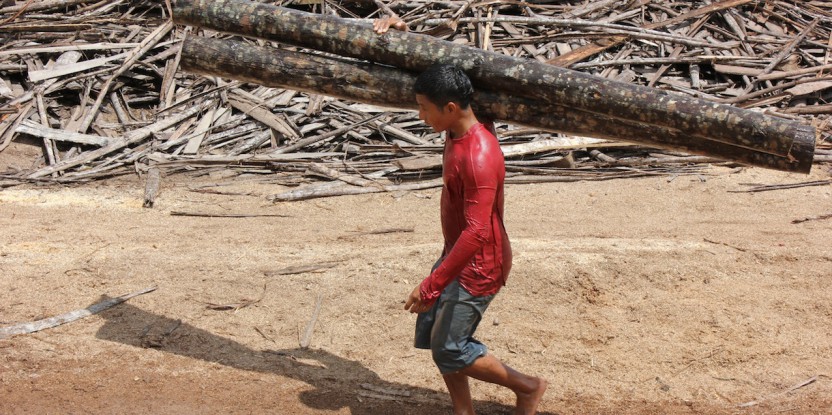
SAN JOSE, Costa Rica (15 August, 2013) — Smallholder farmers in the Amazon sell timber from trees that have grown on fallow fields to improve income, but such production can go unrecognized in official statistics — often because it is commercialized through informal channels, according to research.
“Although this kind of timber harvesting has a low impact and does not affect primary forest, it’s generally illegal because farmers lack land titles and forestry permits,” said Peter Cronkleton, a senior scientist with the Center for International Forestry Research (CIFOR).
Cronkleton presented findings about “Institutional adaptation in smallholder timber management systems in Peru and Ecuador” at the Third Latin American Congress of the International Union of Forestry Research Organizations (IUFRO) in San José, Costa Rica.
“Forest laws are usually designed for large-scale production, so the costs of compliance are too high for small-scale producers,” Cronkleton said. “Doing forest inventories and annual operating plans is beyond the means of small farmers, not just technically, but also financially.”
Although the smallholders he surveyed in the Peruvian and Ecuadoran Amazon mainly depend on farming, income from forest products is also important, and farmers have found special niches in local markets, Cronkleton said.
LIVELIHOOD BENEFITS
When fruit growers in Ecuador’s Napo province need crates, they turn to small sawmill operators who approach Kichwa indigenous communities to get lumber from a tree known locally as pigüe(Piptocoma dicolor) in second-growth forest on their small parcels of land, he said.
The families observed in the study typically harvested about 12 cubic meters (424 cubic feet) of timber at an average price of $12 per cubic meter, Cronkleton said. The harvester’s income is low, but sufficient for such urgent needs as school supplies at the beginning of the school year, he said.
However, only families within 1.5 kms (.93 miles) of a road or river sell timber because transporting pigüe longer distances is too costly.
Near the city of Pucallpa, in Peru’s Ucayali region, small farmers take advantage of bolaina (Guazuma crinita) trees that grow along rivers and in fields that have been left fallow for six or seven years to recover fertility.
The straight-growing bolaina is in demand for siding for low-income houses. The producers have been able to benefit by transforming the wood to add value, and farmers can triple their income by selling planks rather than raw timber, Cronkleton said. The wood is cut at small sawmills that spring up in rural areas to provide services to farmers, also generating employment.
These types of timber, which regenerate as part of the agricultural fallow cycle, are part of an agroforestry “mosaic” important to smallholders’ livelihoods, but ignored in both agriculture and forest-management policy, he said.
“These producers are often blamed for deforestation, but they also regenerate a lot of forest – these areas are working forests,” Cronkleton said.
“There may be an initial expansion of deforestation, but then it becomes a mosaic cycle of forest patches, second-growth forest and fallows successions — not necessarily a problem.”
To encourage them to manage and conserve forests, however, laws should enable smallholders to participate in local markets, giving them rights over forested areas and allowing them to sell timber legally, he said.
Similar findings have emerged from studies in Bolivia.
“If smallholders are not pushed out by ranchers or oil palm plantations, they can establish fairly stable landscapes where they’re able to use very low-input agricultural systems, that also produce a variety of forest products” Cronkleton said. “Under the right conditions, they can be very sustainable.”
For more information on the topics discussed in this article, please contact Peter Cronkleton at p.cronkleton@cgiar.org
This work forms part of the CGIAR Research Program on Forests, Trees and Agroforestry.
We want you to share Forests News content, which is licensed under Creative Commons Attribution-NonCommercial-ShareAlike 4.0 International (CC BY-NC-SA 4.0). This means you are free to redistribute our material for non-commercial purposes. All we ask is that you give Forests News appropriate credit and link to the original Forests News content, indicate if changes were made, and distribute your contributions under the same Creative Commons license. You must notify Forests News if you repost, reprint or reuse our materials by contacting forestsnews@cifor-icraf.org.